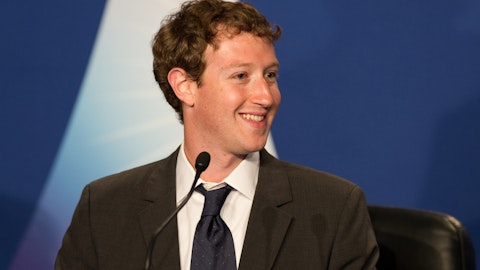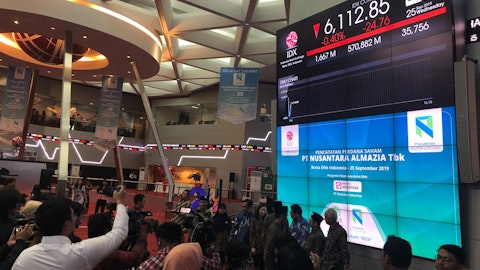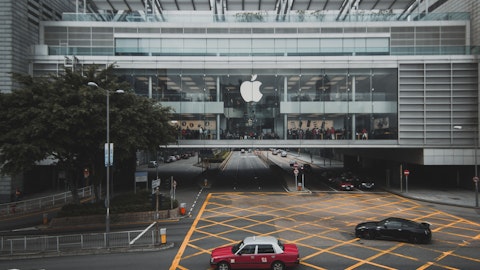Meta Platforms, Inc. (NASDAQ:META) Q4 2022 Earnings Call Transcript February 1, 2023
Operator: Good afternoon. My name is Dave and I will be your conference operator today. At this time, I would like to welcome everyone to the Meta Fourth Quarter and Full Year 2022 Earnings Conference Call. This call will be recorded. Thank you very much. Ms. Deborah Crawford, Meta’s Vice President of Investor Relations, you may begin.
Deborah Crawford: Thank you. Good afternoon and welcome to Meta Platform’s fourth quarter 2022 earnings conference call. Joining me today to discuss our results are Mark Zuckerberg, CEO; and Susan Li, CFO. Javier Olivan, COO, is also on the call and will join Mark and Susan for the Q&A portion. Before we get started, I would like to take this opportunity to remind you that our remarks today will include forward-looking statements. Actual results may differ materially from those contemplated by these forward-looking statements. Factors that could cause these results to differ materially are set forth in today’s press release and in our quarterly report on Form 10-Q filed with the SEC. Any forward-looking statements that we make on this call are based on assumptions as of today and we undertake no obligation to update these statements as a result of new information or future events.
During this call, we may present both GAAP and non-GAAP financial measures. A reconciliation of GAAP to non-GAAP measures is included in today’s earnings press release. The press release and an accompanying investor presentation are available on our website at investor.fb.com. And now, I’d like to turn the call over to Mark.
Mark Zuckerberg: Alright. Hey, everyone and thanks for joining us today. 2022 is a challenging year, but I think we ended it having made good progress on our main priorities and setting ourselves up to deliver better results this year as long as we keep pushing on efficiency. And I said last quarter that I thought our product trends look better than most of the commentary out there suggests. And I think that’s even more the case now. We reached more than 3.7 billion people monthly across our Family of Apps. On Facebook, we now reached 2 billion daily actives and almost 3 billion monthly. The number of people daily using Facebook, Instagram and WhatsApp is the highest it’s ever been. Now before getting into our product priorities, I want to discuss my management theme for 2023, which is the Year of Efficiency.
We closed last year with some difficult layoffs and restructuring some teams. And when we did this, I said clearly that this was the beginning of our focus on efficiency and not the end. And since then, we have taken some additional steps, like working with our infrastructure team on how to deliver our roadmap while spending less on CapEx. Next, we are working on flattening our org structure and removing some layers of middle management to make decisions faster as well as deploying AI tools to help our engineers be more productive. As part of this, we are going to be more proactive about cutting projects that aren’t performing or may no longer be as crucial. But my main focus is on increasing the efficiency of how we execute our top priorities.
So I think that there is going to be some more that we can do to improve our productivity, speed and cost structure. And by working on this over a sustained period, I think we will both build a stronger technology company and become more profitable. I am very focused on doing this in a way that helps us build better products. And because of that, even if our business outperforms our goals, this will stay our management theme for the year since I think it’s going to make us a better company. Now at the same time, I am also focused on delivering better financial results than what we have reported recently and on meeting the expectation that I outlined last year of delivering compounding earnings growth even while investing aggressively in future technology.
And next, I want to give some updates on our priority areas. Our priorities haven’t changed since last year. The two major technological waves driving our roadmap are AI today and over the longer term, the metaverse. So first, let’s talk about our AI discovery engine. Facebook and Instagram are shifting from being organized solely around people and accounts you follow to increasingly showing more relevant content recommended by our AI systems. And this covers every content format, which is something that makes our services unique. But we are especially focused on short-form video since Reels is growing so quickly. And I am really proud of our progress here. Reels plays across Facebook and Instagram have more than doubled over the last year, while the social component of people resharing Reels has grown even faster and has more than doubled on both apps in just the last 6 months.
The next bottleneck that we are focused on to continue growing Reels is improving monetization efficiency or the revenue that’s generated per minute of Reels watched. Currently, the monetization efficiency of Reels is much less than Feed. So the more that Reels grows, even though it adds engagement to the system overall, it takes some time away from Feed and we actually lose money. But people want to see more Reels though. So the key to unlocking that is improving our monetization efficiencies that way we can show more Reels without losing increasing amounts of money. We are making progress here and our monetization efficiency on Facebook has doubled in the past 6 months. In terms of the revenue headwind, we are still on track to be roughly neutral by the end of this year or maybe early next year.
And then after that, we should be able to profitably grow Reels while keeping up with the demand that we see. In our broader ads business, we are continuing to invest in AI and we are seeing our efforts pay off here. In the last quarter, advertisers saw over 20% more conversions than in the year before. And combined with the decline in cost per acquisition, this has resulted in higher returns on ad spend. We continue to be excited about the monetization opportunity with Business Messaging, too. Facebook and Instagram are the first two pillars of our business. And in the next few years, we hope to bring Messaging Online as the next pillar. One way of doing this is click-to-message ads, which is now the $10 billion run-rate. And paid messaging is the other piece of this.
We are earlier here, but we continue to onboard more businesses to the WhatsApp Business Platform where they can answer customer questions and updates and sell directly in chat. So for example, Air France has started using WhatsApp to share boarding passes and other information, other flight information, in 22 countries and 4 languages. And businesses often tell us that more people open their messages and they get better results on WhatsApp than other channels. AI, it’s the foundation of our discovery engine and our ads business. And we also think that it’s going to enable many new products and additional transformations in our apps. Generative AI is an extremely exciting new area with so many different applications. And one of my goals for Meta is to build on our research to become a leader in generative AI in addition to our leading work in recommendation AI.
The last area that I want to talk about is the Metaverse. We shipped Quest Pro at the end of last year. I am really proud of it. It’s the first mainstream mixed reality device. I mean, we are setting the standard for the industry with our Meta Reality system. As always, the reason why we are focused on building these platforms is to deliver better social experiences, than what’s possible today on phones. And the value of MR is that you can experience the immersion and presence of VR while still being grounded in the physical world around you. We are already seeing developers build out some impressive new experiences like Nanome for 3D modeling, molecules and drug development; Arkio for architects and designers to create interiors; and of course, a lot of great games.
The MR ecosystem is relatively new, but I think it’s going to grow a lot over the next few years. Later this year, we are going to launch our next-generation consumer headset, which will feature Meta Reality as well. And I expect that this is going to establish this technology as the baseline for all headsets going forward and eventually, of course, for AR glasses as well. Beyond MR, the broader VR ecosystem continues growing. There are now over 200 apps on our VR devices that have made more than $1 million in revenue. We are also continuing to make progress with avatars. We just launched avatars on WhatsApp last quarter and more than 100 million people have already created avatars in the app. And of those, about 1 in 5 are using their avatar as their WhatsApp profile photo.
I thought that, that was an interesting example of how the Family of Apps and Metaverse visions come together, because even though most of our Reality Labs investment is going towards future computing platforms, glasses, headsets and the software to run them, as the technology develops, most people are going to experience the Metaverse for the first time on phones and then start building up their digital identities across our apps. Alright. So those are the areas we are focused on, AI, including our discovery engine, ads, business messaging and increasingly generative AI and the future platforms for the Metaverse. And from an operating perspective, we are focused on efficiency and continuing to streamline the company so we can execute these priorities as well as possible and build a better company while improving our business performance.
And as always, I am grateful to our teams for your work on all of these important areas and to all of you for being on this journey with us. And now over to Susan.
Susan Li: Thanks, Mark and good afternoon everyone. Let’s begin with our consolidated results. All comparisons are on a year-over-year basis, unless otherwise noted. Q4 total revenue was $32.2 billion, down 4% or up 2% year-over-year on a constant currency basis. Had foreign exchange rates remained constant with Q4 of last year, total revenue would have been approximately $2 billion higher. Q4 total expenses were $25.8 billion, up 22% compared to last year. In terms of the specific line items, cost of revenue increased 31%, driven mostly by a write-down of certain data center assets as well as growth in infrastructure-related costs. R&D increased 39%, marketing and sales increased 4%, and G&A decreased 7%. Operating lease impairments and employee-related costs were the largest contributors to growth for all three expense lines.
However, growth in marketing and sales was partially offset by lower marketing spend and growth in G&A was more than fully offset by a decrease in legal-related expenses. We ended the fourth quarter with over 86,400 employees, which includes a substantial majority of the approximately 11,000 employees impacted by our previously announced layoffs who remained on payroll as of December 31 due to applicable legal requirements. We expect the vast majority of the impacted employees will no longer be captured in our reported headcount figures by the end of the first quarter of 2023. Fourth quarter operating income was $6.4 billion, representing a 20% operating margin. Our tax rate for the quarter was 24%. Net income was $4.7 billion or $1.76 per share.
Capital expenditures, including principal payments on finance leases, were $9.2 billion, driven by investments in servers, data centers and network infrastructure. Free cash flow was $5.3 billion and we ended the year with $40.7 billion in cash and marketable securities. In the fourth quarter, we repurchased $6.9 billion of our Class A common stock, bringing our total share repurchases for the full year to $27.9 billion. We had $10.9 billion remaining on our prior authorization as of December 31. And today, we announced a $40 billion increase in our stock repurchase authorization. Moving now to our segment results. I will begin with our Family of Apps segment. Our community across the Family of Apps continues to grow. We estimate that approximately 2.96 billion people used at least one of our Family of Apps on a daily basis in December and that approximately 3.74 billion people used at least one on a monthly basis.
Facebook continues to grow globally and engagement remains strong. We reached 2 billion Facebook daily active users for the first time in December, up 4% or 71 million compared to last year. DAUs represented approximately 67% of the 2.96 billion monthly active users in December. MAUs grew by 51 million or 2% compared to last year. Q4 total Family of Apps revenue was $31.4 billion, down 4% year-over-year. Q4 Family of Apps ad revenue was $31.3 billion, down 4%, but up 2% on a constant currency basis. Consistent with our expectations, Q4 revenue remained under pressure from weak advertising demand which we believe continues to be impacted by the uncertain and volatile macroeconomic landscape. The financial services and technology verticals were the largest negative contributors to the year-over-year decline in Q4, but both have relatively smaller shares of our revenue.
Growth remained negative in our largest verticals, online commerce and CPG, though the pace of year-over-year decline in online commerce has slowed compared to last quarter. The largest positive contributors to year-over-year growth in Q4 were the travel and healthcare verticals, though both are relatively smaller verticals in absolute share. Foreign currency remained a significant headwind to advertising revenue growth in all international regions. On a user geography basis, ad revenue growth was strongest in Rest of World at 5%. North America was flat, while Asia-Pacific and Europe declined 3% and 16% respectively. In Q4, the total number of ad impressions served across our services increased 23% and the average price per ad decreased 22%.
Impression growth was primarily driven by the Asia-Pacific and Rest of World regions. The year-over-year decline in pricing was primarily driven by strong impression growth, especially from lower monetizing surfaces and regions, lower advertiser demand and foreign currency depreciation. While overall pricing remains under pressure from these factors, we have continued to make improvements to our ads targeting and measurement that we believe are driving more conversions and better returns for advertisers. Family of Apps’ other revenue was $184 million in Q4, up 19%, with strong business messaging revenue growth from our WhatsApp business platform partially offset by a decline in other line items. We continue to direct the majority of our investments towards the development and operation of our Family of Apps.

Photo by Timothy Hales Bennett on Unsplash
In Q4, Family of Apps expenses were $20.8 billion, representing 81% of our overall expenses. Family of Apps’ expenses were up 23% due primarily to restructuring-related expenses and growth in infrastructure-related costs. Family of Apps’ operating income was $10.7 billion, representing a 34% operating margin. Within our Reality Labs segment, Q4 revenue was $727 million, down 17% due to lower Quest 2 sales. Reality Labs expenses were $5 billion, up 20% due primarily to employee-related costs and restructuring-related expenses. Reality Labs operating loss was $4.3 billion. Before turning to the outlook, I’d like to discuss our work to grow profitability by scaling monetization and improving our operational efficiency. There are two primary levers to increasing monetization: growing supply and growing demand.
Growing ad supply gives businesses more opportunities to get in front of people and we are focused on enabling that in a couple of ways. First and foremost, we remain focused on building engaging experiences for the people who use our apps. We are coming into 2023 with a strong foundation as Reels continues to scale and we are seeing in-feed recommendations contribute to engagement as we help people discover new content in their feeds. We will continue to invest in making these experiences best-in-class. The other side of growing supply comes from more effectively monetizing the surfaces within our apps, including those that have a lower level of ads today. In the nearer term, ramping Reels monetization remains a primary focus. Over the longer term, we see opportunities to continue improving Facebook and Instagram monetization while also scaling revenue contributions from our messaging platforms.
Growing advertiser demand is the other focus and a big effort here is around continuing to drive advertiser performance. While we are still contending with the broader macro uncertainty and signals landscape weighing on advertiser demand in the near-term, we are making good progress on our roadmap and are already seeing improvements to add performance and measurement from the investments we have made. We see opportunities for continued gains in the near and medium-term, with our AI investments powering a lot of this work as we continue to improve ads ranking and enable increased automation for advertisers to make it easier for them to run campaigns and use our systems to optimize their performance. Another opportunity we have is to further scale onsite conversions through products like click-to-message, lead ads and shop ads.
Click-to-message ads continue to grow quickly and we believe they are bringing incremental demand onto our platform, with over half of click-to-message advertisers exclusively using click-to-messaging ads on our platform. We see further opportunity as we continue to scale click-to-WhatsApp ads and are investing in growing newer formats like shop ads. Over the long-term, we are investing heavily in AI to develop and deploy privacy-enhancing technologies and continue building new tools that will make it easier for advertisers to create and deliver more relevant and engaging ads. Moving now to our efficiency work, we took significant actions in 2022 to operate more efficiently. In Q4, we made the difficult decision to layoff employees while deprioritizing certain projects and curtailing non-headcount-related expenses.
We have applied the same scrutiny to our physical assets. We identified opportunities to consolidate our office facilities and we have streamlined our future data centers to a new architecture, which we believe will be more cost efficient and more flexible that provides us optionality to support both AI and non-AI workloads. In Q4, we recorded $4.2 billion of total restructuring costs in connection with all of these efforts and expect there to be some additional costs in 2023 in areas like office facilities impairments as we continue this work. As Mark has said, these actions are just the beginning of our efficiency efforts, and we remain keenly focused on this in 2023. We are working across the company to deprioritize lower ROI work, move faster, increase productivity and reduce costs across the business.
As part of this, we are carefully scrutinizing our hiring needs, actively reevaluating projects and reducing management layers. I’m confident that our company-wide focus on efficiency will position us to be an even more productive organization going forward. Turning now to the revenue outlook, we expect first quarter 2023 total revenue to be in the range of $26 billion to $28.5 billion. Our guidance assumes foreign currency will be an approximately 2% headwind to year-over-year total revenue growth in the first quarter based on current exchange rates. Turning now to the expense outlook, we anticipate our full year 2023 total expenses will be in the range of $89 billion to $95 billion, lower from our prior outlook of $94 billion to $100 billion due to slower anticipated growth in payroll expenses and cost of revenue.
We now expect to record an estimated $1 billion in restructuring charges in 2023 related to consolidating our office facilities footprint. This is down from our prior estimate of $2 billion as we recorded a portion of the charges in the fourth quarter of 2022. We may incur additional restructuring charges as we progress further in our efficiency efforts. Turning now to the CapEx outlook for 2023, we expect capital expenditures to be in the range of $30 billion to $33 billion, lowered from our prior estimate of $34 billion to $37 billion. The reduced outlook reflects our updated plans for lower data center construction spend in 2023 as we shift to a new data center architecture that is more cost efficient and can support both AI and non-AI workloads.
Substantially, all of our capital expenditures continue to support the Family of Apps. On to tax. Absent any changes to U.S. tax law, we expect our full year 2023 tax rate percentage to be in the low 20s. In addition, as noted on previous calls, we continue to monitor developments regarding the viability of transatlantic data transfers and their potential impact on our European operations. In closing, 2022 was a challenging but pivotal year for our business. We made important progress on our priorities and have taken significant steps to improve our efficiency and productivity. We are set up well to build on this work in 2023 as we continue investing for future growth while remaining focused on delivering strong financial performance. With that, Dave, let’s open up the call for questions.
See also 20 Biggest Nonalcoholic Beverage Companies in the US and 30 Largest Trading Partners of the US.
Q&A Session
Follow Meta Platforms Inc. (NASDAQ:META)
Follow Meta Platforms Inc. (NASDAQ:META)
Operator: Thank you. Your first question comes from the line of Brian Nowak with Morgan Stanley. Your line is open.
Brian Nowak: Great. Thanks for taking my questions. I have two, one for Mark, one for Susan. Mark, the first one is on generative AI. I sort of wanted to dig a little more into how you think about your blue-sky potential user and advertiser use cases of generative AI? And how do you think about the timeline foresee some glimpses of those on the platform? And then the second one for Susan, just anymore color on the new data center architecture and how we should think about the long-term capital intensity of the business, whether it’s CapEx per minute, CapEx per DAU? How big of a long-term benefit could this change be to the overall cash flow? Thanks.
Mark Zuckerberg: Yes, I can start with generative AI. Yes, I think this is a really exciting area. And I mean, I’d say the two biggest themes that focused on for this year and one is efficiency and then the kind of the new product area is going to be the generative AI work. We have a bunch of different work streams across almost every single one of our products to use the new technologies, especially the large language models and diffusion models for generating images and videos and avatars and 3D assets and all kinds of different stuff across all of the different work streams that we’re working on, as well as over the long-term, working on things that could really empower creators to be way more productive and creative across the apps and run a lot of different accounts.
So I know there is some really exciting stuff here. I want to be careful not to kind of get too far ahead of the development of it. So I think you’ll see us launch a number of different things this year, and we will talk about them, and we will share updates on how they are doing. I do expect that the space will move quickly. I think we will learn a lot about what works and what doesn’t. A lot of the stuff is expensive, right, to kind of generate an image or a video or a chat interaction. These things we’re talking about, like cents or fraction of a cent. So one of the big interesting challenges here also is going to be how do we scale this and make this work more efficient so way we can bring it to a much larger user base. But I think once we do that, there are going to be a number of very exciting use cases.
I realize this is a pretty high-level answer for now, but I think that we will be able to share more details over the coming months.
Susan Li: Thanks, Brian. On your questions about CapEx, so your first question was about the new data center architecture that we talked about, which is underpinning the lower CapEx outlook. So we’re shifting our data centers to a new architecture that can more efficiently support both AI and non-AI workloads. And that’s going to give us more optionality as we better understand our demand for AI over time. Additionally, we’re expecting that the new design will be cheaper and faster to build than previous data center architecture. Along with the new data center architecture, we’re going to optimize our approach to building data centers. So we have a new phased approach that allows us to build base plans with less initial capacity and less initial capital outlay, but then flex up future capacity quickly if needed.
We’re still planning to grow AI capacity significantly, and that connects, I think, to a lot of the things that Mark was describing earlier in his question. In terms of longer-run capital intensity, we certainly expect that the lower CapEx outlook will have some incremental benefit to CapEx as a percent of revenue, and that’s still really something that we are focused on over the longer term. The current surge in CapEx is really due to the building out of AI infrastructure, which we really began last year and are continuing into this year. We will be measuring the ROI of these AI investments, and their returns will continue to inform our future spend. Our intention is still to bring CapEx as a percent of revenue down, but capital intensity in the nearest term is really going to depend, in part, on the revenue outlook and our needs to further build AI capacity for future demand.
Operator: Your next question comes from the line of Eric Sheridan with Goldman Sachs. Your line is open.
Eric Sheridan: Thank you so much. Maybe I can ask a multiparter on going back to some of your comments on Reels. Mark, you always had this philosophy of letting the user sort of continue to grow engagement, and monetization has always lagged sort of consumer adoption of new products. How do you think about going a little bit deeper on the mixture of letting the engagement of short-form video continue to build versus eventually sort of continuing to drive higher levels of monetization against that product? Second, can you give us a little bit of color of how advertiser conversations continue to evolve around short-form video and the adoption of the Canvas and the utilization of that as a means to deliver a mixture of brand and DR messages?
And then lastly would just be, can you quantify at all the gap that still exists between the engagement around short-form video and the monetization and how that might close as we look out over the next couple of years? Thanks so much.
Mark Zuckerberg: Yes. I mean the way I’ve always looked at I can take the first part of this, is that for these consumer products, often building up and scaling the product use case is a somewhat different discipline than working on the monetization. So it’s such a kind of hard problem to build these new types of products that you want to give the teams as much clarity and as simple of goals as possible. So in the beginning, just saying, okay, just let’s make something that works for people. And then once we get to many hundreds of millions of people or billions of people using it, then we will focus on ramping up the monetization, which has been a formula that’s worked for us. That’s the general approach. Now with Reels, we do have a lot of people using it now.
So I think at this point, the question is, is there any strategic advantage to letting it scale further than will be than would be profitable to do? And I think at the scale that it’s at right now, it’s not clear that there is much strategic advantage. I mean there are certain flywheels, and you get certain more feedback or data points from a little bit more distribution. But at this point, we’re at pretty good scale. So I think for now, the right thing to do is to work on monetization efficiency. And we know that there is demand to see some more Reels. And as we naturally improve the monetization efficiency, which I have confidence in because the teams are doing good work, and that’s been working, I shared the stat about it, the efficiency doubling over the last 6 months on Facebook, I think as we can continue some of those trends, then we will naturally just unlock the ability to show more and more Reels, and we will continue to grow from there.
But that’s the overall approach. I do think that our philosophy of building these consumer products, focusing on getting them to hundreds of millions or billions of people and then focusing on monetization beyond that and bringing that in as the balance is the right approach. It served us well. You can expect us to continue doing that on future things that we do, including some hopefully, some of the new generative AI products or some of the new Metaverse stuff that we’re doing. We’re going to take the same approach there as well.





